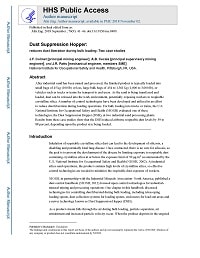Mining Publication: Dust Suppression Hopper Reduces Dust Liberation During Bulk Loading: Two Case Studies
Original creation date: September 2018
Authors: J Colinet, A Cecala, J Patts
After industrial sand has been mined and processed, the finished product is typically loaded into small bags of 45 kg (100 lb) or less, large bulk bags of 454 to 1,361 kg (1,000 to 3,000 lb), or vehicles such as trucks or trains for transport to end users. As the sand is being transferred and loaded, dust can be released into the work environment, potentially exposing workers to respirable crystalline silica. A number of control technologies have been developed and utilized in an effort to reduce dust liberation during loading operations. For bulk loading into trucks or trains, the U.S. National Institute for Occupational Safety and Health (NIOSH) evaluated one of these technologies, the Dust Suppression Hopper (DSH), at two industrial sand processing plants. Results from these case studies show that the DSH reduced airborne respirable dust levels by 39 to 88 percent, depending upon the product size being loaded.

- Control of Respirable Dust
- Emerging Respirable Dust Sensing and Control for M/NM Mining
- Field Assessment of Control Techniques and Long-Term Dust Variability for Surface Coal Mine Rock Drills and Bulldozers
- Forty Years of NIOSH/USBM-developed Control Technology to Reduce Respirable Dust Exposure for Miners in Industrial Minerals Processing Operations
- Improved Dust Control for Bag Handlers
- Improving Silica Dust Control Through Targeted Research
- Improving the Performance of Fan-Powered Dust Collectors in Stone-Cutting Applications
- Infographics: Helping Mines Control Respirable Silica Dust
- List of respirable crystalline silica monitoring and control resources
- Respirable Dust